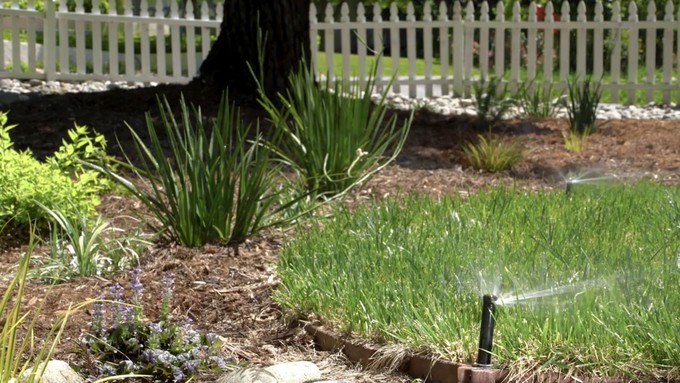
Cycle and soak method is the best way to irrigate lawns in summer, especially in clay soil

"Cycle and soak" watering is recommended for lawns and gardens with clay soil. Screenshot from "How to Know If Your Yard Needs Water" video/BeWaterSmart.info
How can you keep a lawn green during the heat of summer? The answer is not more water, but how that water is applied.
Folks see yellow spots on their lawn, they increase the run time on their sprinklers, says Justin Black, water conservation specialist for City of Roseville Water. Instead of greening that grass, the extra water tends to just run off – especially if that lawn is growing in clay soil.
Soil needs time for water to soak in. Otherwise, excess irrigation flows over the surface – and down the gutter.
Notoriously slow draining, clay soils – the most common in many Sacramento-area communities – quickly become saturated; all the pores and air spaces between those tiny clay particles become filled with water. When saturated, soil can’t accept any more water.
“Clay-based soil with a slight slope becomes saturated in three to five minutes,” Black says. “So, the key (to avoiding runoff) is to keep you sprinkler run time under four minutes.”
One four-minute application may not be enough – particularly in July. That’s when local landscapes have their highest water demands. The solution: Cycle and soak.
Explains Black, “Cycle and soak is a way of dividing up your sprinklers’ run time so you maximize the amount of water going into the ground and avoid runoff. Most people run their sprinklers for 10 minutes. Instead run them three times for three minutes, one hour apart. That allows the pores near the surface to fill and (the water) to seep down to the root zone. You use less water, but it’s more effective.”
Be patient; clay soil takes its time.
“Largely what we have here (in Roseville and much of the Sacramento area) is clay soil, and clay can be pretty extreme,” Black notes. In full (or all) clay soil, water soaks in at the rate of .03 inches per hour. Traditional sprinkler systems deliver 1.5 inches of water per hour – 50 times the full clay soak rate.
While clay heavy, most of our soils aren’t “full clay”; an hour between sprinkler applications is usually enough time for water to soak down to a lawn’s root zone.
“Cool-season turfgrasses – and that’s what most people grow – need about 64 minutes a week on spray sprinklers in July; that’s the maximum,” Black says. “For 100% (of that maximum), run the sprinklers four days, four times (a day) for four minutes.”
Another way to break down that 64 minutes: Two days, eight times a day – split between early morning and early evening – for four minutes.
“When setting up a smart controller, program for the hottest weather – that maximum water use – then work down from there,” Black explains. “Then, seasonally adjust amounts on your controller down from that high point.”
That’s where a smart irrigation controller comes in really handy. Once programmed, it takes care of those adjustments.
“Your sensors will do it automatically,” Black notes.
Smart controllers also allow more flexibility with setting multiple short run times.
Setting up the smart controller, which uses an app for easy access, can be daunting. The most common mistake is inputting the wrong basic information for the specific landscape.
For local lawns, the most common settings include cool-season turfgrass, full sun, clay soil and 10 to 15% slope.
“Programming for warm-season grass when you have cool-season, your lawn won’t get enough water,” Black says.
Help get the most out of the cycle-and-soak method with rotary sprinkler nozzles. Bigger drops come out of the rotating heads at a slower rate than traditional spray sprinklers, cutting down on evaporation and waste.
When upgrading sprinkler heads, make sure to change out all the heads on an irrigation station, Black advises. “Keeping the same is important instead of mismatching. When you mismatch, you damage distribution uniformity (DU) – how the water is distributed. With a system with 50% DU, to keep areas alive (with lower DU), you have to double-water other areas. Anything you can do to promote DU really makes a difference.”
So does proper watering overall.
“With the cycle and soak method, you can save water and still have greener, healthier grass,” Black says. “Because you’re minimizing runoff, you get more water to the root zone and better looking plants as a result.”
Find rebates for irrigation upgrades at BeWaterSmart.info.
------
Note: The information in Monday's blog post attributed to the El Dorado master gardeners in fact originated with the Placer County master gardeners. Neighborly El Dorado had shared the quotes on Facebook. Thanks to both UCCE master gardener groups for keeping gardeners informed.
Comments
0 comments have been posted.Sacramento Digs Gardening to your inbox.
Sites We Like
Garden Checklist for week of May 5
Survey your garden after the May 4 rainstorm. Heavy rain and gusty winds can break the neck of large flowers such as roses. Also:
* Keep an eye on new transplants or seedlings; they could take a pounding from the rain.
* Watch out for powdery mildew. Warmth following moist conditions can cause this fungal disease to “bloom,” too. If you see a leaf that looks like it’s dusted with powdered sugar, snip it off.
* After the storm, start setting out tomato transplants, but wait on the peppers and eggplants (they want warmer nights). Pinch off any flowers on new transplants to make them concentrate on establishing roots instead of setting premature fruit.
* Trim dead flowers but not leaves from spring-flowering bulbs such as daffodils and tulips. Those leaves gather energy to create next year's flowers. Also, give the bulbs a fertilizer boost after bloom.
* Pinch chrysanthemums back to 12 inches for fall flowers. Cut old stems to the ground.
* Mulch around plants to conserve moisture and control weeds.
* From seed, plant beans, beets, cantaloupes, carrots, corn, cucumbers, melons, pumpkins, radishes and squash.
* Plant onion sets.
* In the flower garden, plant seeds for asters, cosmos, celosia, marigolds, salvia, sunflowers and zinnias. Transplant petunias, zinnias, geraniums and other summer bloomers.
* Plant perennials and dahlia tubers for summer bloom.
* Don’t wait; plant summer bulbs, such as gladiolus and tuberous begonias.
* Harvest cabbage, lettuce, peas and green onions.